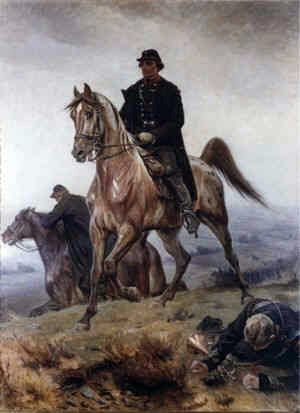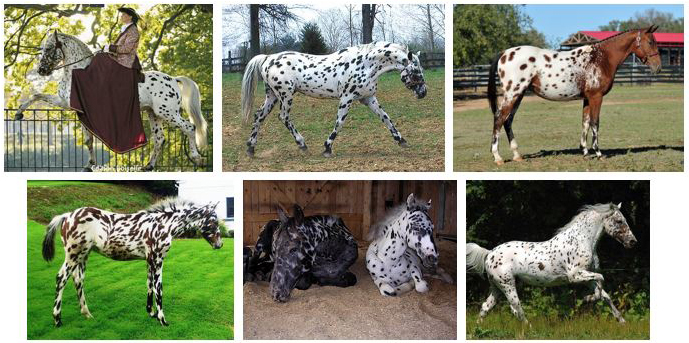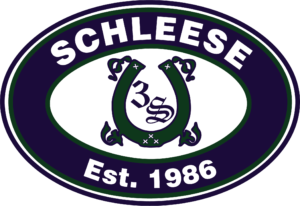Breeding to Save a Population
I am taking the occasional online courses through the Equine Sciences Faculty at Guelph University in an attempt to continue my own personal education in the equestrian industry; this past winter I studied an Equine Genetics course. (I have to say it was pretty challenging, especially since it has been about 40+ years since I actually graduated from the College of Biological Sciences!) It was however, extremely interesting, and for my final essay I chose this topic and the Knabstrupper horse to profile. I have to explain why I chose this relatively obscure, unique and somewhat esoteric breed. (It was between this and the Marwari horse of India, which is another very unusual breed). Some of the information below comes from www.knabstruppers.com and some from Wikipedia and this blog is an edited version of my actual essay.

While in the process of translating my father’s many photo albums and memoirs from German into English for our family’s posterity, I came across this picture he took while on vacation in Salzburg from his duties as a U-Boot Commander. The inscription under the photo reads “this is who met me as I left the train station.”
In addition, one of my favourite stories as a child was “Pippi Longstocking” with her (presumably) Knabstrupper dalmation spotted horse. Although in German she just called him “Pferd”, opinions differ as to what his actual name was. My love of horses (from afar, for the most part while growing up) began with Pferd. Plus, I just love saying the name. “Knabstrupper”.
Knapstruppers are a relatively new breed in North America; it was not until 2002 that they were introduced here from Europe. In fact, the breed itself is relatively new in general – having only been established in 1812 in Denmark. It all started with a chestnut mare with leopard complex spotting (bred to a solid-coloured stallion) and producing a colt with even more dramatic spotting. This mare and her son were then bred to numerous other horses, producing many offspring with spotting and thereby establishing a new breed of horse.

The irony is that crossbreeding with other horses (especially Appaloosas) over the past 50 years makes it difficult to ascertain whether there are even any true Knabstrupper purebreds left. When they were close to completely dying out in the mid 1900’s, three Appaloosa stallions made the trek over to Denmark to add new blood to the breed. Even the American origins of the breed was based on three exceptional Appaloosa mares who were mated to the premier European Knabstrupper Stallion “Apollon” via frozen semen.
The very closely related American Appaloosa also developed directly from the Spanish spotted horses that were brought to America in the early 1500s by Cortez from Spain. Although the spotted colour patterns are very similar and they do share the same colour genes, the two breeds did develop independently of one another.
One mare, who only had spotted foals, was instrumental in establishing the breed characteristics. Her progeny were all high spirited and energetic, not temperamental and without any of the stereotypical vices such as cribbing or weaving. The fact that these horses were generally never kept in stalls, but left outside, accounts for their ruggedness and stamina. They were all known to live to a high age. (Of course, with proper horse management this is still possible today).
Although the Knabstruppers were popular for military use by Danish officers during the war of 1848-1850 (the Schleswig war), their striking appearance made them excellent targets. Unfortunately by the 1870s the further continuation of the breed was once again threatened due to the limited number of Knabstrupper horses available and the problems of inbreeding
Although there were several attempts to revive the breed, it took until 1971 for new blood to be infused into the Knapstruppers from three Appaloosas brought to Denmark. At this point then the Knabstrupp Association (Knabstrupperforeningen for Danmark) was formed, and any horse with spots or approximate patterning was registered. Stallions were only selected if they actually had the spots.
Three distinct types of Knabstruppers have developed:
- The Sport Horse type – bred to excel in dressage, eventing and show jumping. Crossbred with Trakehners and Danish Warmbloods. From 15.2-16 hh
- The Baroque type – shorter, broader, and used for driving carriages or in military duty. It was also popular in the circus and was likely the physique of Pippi Longstocking’s horse. From 14.2-15.2hh
- The Pony type – smaller and a favourite with children, especially in Europe. Under 14.2 hh. Further matings have produced even Shetland sized ponies with the distinct colouration of a Knabstrupper

The spotted colouration is difficult to control. There is no guarantee that even with two spotted horses being bred that spotted foals will result, as the leopard complex spotting gene is recessive – and linked to congenital night blindness.
These are the most popular variations of spotting in the Knabstruppers:
- Leopard Spot: white horse with evenly distributed spots
- Near Leopard: similar to a) but with solid-coloured head and legs
- Spotted Blanket: mainly solid-coloured but with white back/hindquarters with spots
- White Blanket: mainly solid-coloured but with white back/hindquarters without spots
- Snowflake: solid-coloured with white spots all over the body
- Frosted Hip or Frosted Blanket: Solid-coloured with white frosting or white spots over loin and hips
- Marble: solid-coloured at birth but becomes almost white with age
- Few Spot or Few Spot Leopard: white with just a few spots.
Knabstruppers have expressive heads on well-proportioned necks, long sloping shoulders, strong backs with short muscular loins, and strong-boned limbs. The leopard complex spotting has been a favourite pattern almost since the beginning of equine domestication (about 5500 years ago).
The cave painting “The Dappled Horses of Pech-Merle” in France near the Village of Cabrereet, which dates back more than 25,000 years during the Ice Age clearly depicts white horses with dark spots. The coat pattern portrayed in these paintings are remarkably similar to the pattern we know as “leopard” thought only to appear in modern horses. Changing fashions and repeated cross-breeding of wild and domestic horses has substantially increased the genetic diversity. However, by about 2000 BC the leopard complex spotting almost completely disappeared – one reason might have been the congenital night blindness which accompanies this. The ability to see at night was critical for wild horses for communication, orientation, finding food, and avoiding predators. As such, their chances for survival would be slim – even after domestication horses with night blindness are described as nervous and timid and difficult to handle when it gets dark.
Leopard spotting made its comeback during medieval times, when paintings often show these animals. They were a favourite among the aristocracy and were considered a symbol of chastity.
Coincidentally, we saw a woman recently at a dressage show riding one of these beautifully striking horses and then a few weeks later saw what we thought was another Knabstrupper at a horse trial. Turns out – it was the same woman! She said she loved doing dressage for herself, but did the horse trials for her horse – because he loved to jump. She was absolutely in love with her animal and couldn’t speak highly enough about his temperament, his stamina, his ability, and his willingness to work. (Obviously many horse owners feel the same about their horses, but somehow this was one of the most believable statements I have heard – especially knowing what I now know about the breed!)
May you always see spots before your eyes! (Have you seen a doctor? No – just spots!) 🙂
©2017 Saddlefit 4 Life ® All Rights Reserved
